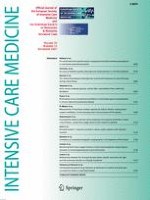Published in:

01-12-2007 | Original
Monitoring brain tissue oxygen tension in brain-injured patients reveals hypoxic episodes in normal-appearing and in peri-focal tissue
Authors:
Luca Longhi, Francesca Pagan, Valerio Valeriani, Sandra Magnoni, Elisa R. Zanier, Valeria Conte, Vincenzo Branca, Nino Stocchetti
Published in:
Intensive Care Medicine
|
Issue 12/2007
Login to get access
Abstract
Objective
We compared brain tissue oxygen tension (PtiO2) measured in peri-focal and in normal-appearing brain parenchyma on computerized tomography (CT) in patients following traumatic brain injury (TBI).
Design
Prospective observational study.
Setting
Neurointensive care unit.
Patients and participants
Thirty-two consecutive TBI patients were subjected to PtiO2 monitoring.
Interventions
Peri-focal tissue was identified by the presence of a hypodense area of the contusion and/or within 1 cm from the core of the contusion. The position of the tip of the PtiO2 probe was assessed at follow-up CT scan.
Measurements and results
Mean PtiO2 in the peri-contusional tissue was 19.7 ± 2.1 mmHg and was lower than PtiO2 in normal-appearing tissue (25.5 ± 1.5 mmHg, p < 0.05), despite a greater cerebral perfusion pressure (CPP) (73.7 ± 2.3 mmHg vs. 67.4 ± 1.4 mmHg, p < 0.05). We observed both in peri-focal tissue and in normal-appearing tissue episodes of brain hypoxia (PtiO2 < 20 mmHg for at least 10 min), whose median duration was longer in peri-focal tissue than in normal-appearing tissue (51% vs. 34% of monitoring time, p < 0.01). In peri-focal tissue, we observed a progressive PtiO2 increase from pathologic to normal values (p < 0.01).
Conclusions
Multiple episodes of brain hypoxia occurred over the first 5 days following severe TBI. PtiO2 was lower in peri-contusional tissue than in normal-appearing tissue. In peri-contusional tissue, a progressive increase of PtiO2 from pathologic to normal values was observed over time, suggestive of an improvement at microcirculatory level.